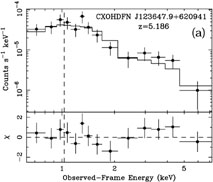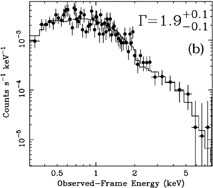


3.4. High-Redshift (z > 4) AGN Demography and Physics
As is apparent from Figures 5 and
10,
deep X-ray surveys can detect z > 4 AGN that
are  10-30 times less
luminous than those found in wide-field optical
AGN surveys such as the SDSS. At least in the local universe, such
moderate-luminosity AGN are much more numerous and thus more
representative than the rare, highly luminous quasars. Furthermore, unlike
the rest-frame ultraviolet light sampled at z > 4 in
ground-based AGN
surveys, X-ray surveys suffer from progressively less absorption
bias as higher redshifts are surveyed. At z > 4, hard
10-30 times less
luminous than those found in wide-field optical
AGN surveys such as the SDSS. At least in the local universe, such
moderate-luminosity AGN are much more numerous and thus more
representative than the rare, highly luminous quasars. Furthermore, unlike
the rest-frame ultraviolet light sampled at z > 4 in
ground-based AGN
surveys, X-ray surveys suffer from progressively less absorption
bias as higher redshifts are surveyed. At z > 4, hard
 2-40 keV
rest-frame X-rays are accessed; these can penetrate large column
densities up to several × 1024 cm-2.
2-40 keV
rest-frame X-rays are accessed; these can penetrate large column
densities up to several × 1024 cm-2.
 |
Figure 10. Observed-frame, Galactic
absorption-corrected 0.5-2 keV flux versus AB1450(1+z)
magnitude for z |
Spectroscopic follow-up of moderate-luminosity X-ray detected AGN at
z > 4 is challenging, since such objects are expected to have
z magnitudes of
23-26 (provided they have not "dropped out" of the z bandpass
entirely).
Nevertheless, significant constraints on the sky density of such objects
have been set via large-telescope spectroscopy and Lyman-break selection.
In the latter case, objects can be selected that either have appropriate
optical/near-infrared colors to be at z > 4 or alternatively have
no optical/near-infrared detections. The "bottom line" from these
demographic studies in the CDF-N and CDF-S is that there are
 12
AGN at z > 4 detectable in a 1-2 Ms Chandra field, and
that only
12
AGN at z > 4 detectable in a 1-2 Ms Chandra field, and
that only  4 of these
have a z magnitude of < 25 (this
limit on the sky density is still ~ 260 times the sky density
of z > 4 quasars from the SDSS). These sky-density constraints
are sufficient to rule out some pre-Chandra predictions by
about an order of magnitude, and the combined X-ray and
SDSS results indicate that the AGN contribution to reionization at
z
4 of these
have a z magnitude of < 25 (this
limit on the sky density is still ~ 260 times the sky density
of z > 4 quasars from the SDSS). These sky-density constraints
are sufficient to rule out some pre-Chandra predictions by
about an order of magnitude, and the combined X-ray and
SDSS results indicate that the AGN contribution to reionization at
z  6 is small.
6 is small.
Once high-redshift AGN have been identified, via either X-ray or
optical surveys, broad-band spectral energy distribution
analyses and X-ray spectral fitting can provide
information on their accretion processes and
environments. The currently available data, albeit limited, suggest
that z > 4 AGN are accreting and growing in roughly the same
way as AGN in the local universe; there is no evidence that their
inner X-ray emitting regions have been affected by, for example,
accretion-disk instabilities or radiation-trapping effects.
Figure 10 plots X-ray versus optical flux for
z > 4 AGN from
both X-ray and optical surveys. The X-ray-to-optical spectral indices,
 ox, for these
objects are consistent with those
of AGN in the local universe, once luminosity effects and selection
biases are taken into account. These biases and effects likely
explain, for example, why the moderate-luminosity, X-ray selected
AGN in Figure 10 have notably higher
X-ray-to-optical flux ratios than the luminous, optically selected quasars.
ox, for these
objects are consistent with those
of AGN in the local universe, once luminosity effects and selection
biases are taken into account. These biases and effects likely
explain, for example, why the moderate-luminosity, X-ray selected
AGN in Figure 10 have notably higher
X-ray-to-optical flux ratios than the luminous, optically selected quasars.
Two recent X-ray spectral fitting results on z > 4 AGN are shown
in Figure 11.
Figure 11a shows the X-ray spectrum of the highest
redshift AGN discovered thus far in the CDF-N, a low-luminosity
quasar at z = 5.186. It was only possible to obtain a
respectable-quality X-ray spectrum for such an object due to the
2 Ms CDF-N exposure. Spectral fitting yields a power-law photon
index of
 = 1.8 ± 0.3,
consistent with observations of
similar objects at low redshift, and there is no evidence for
intrinsic X-ray absorption. Figure 11b shows a
"stacked"
spectrum of 46 luminous radio-quiet quasars at z = 4.0-6.3 (their
median redshift is z = 4.43); this spectrum has 750 counts in
total. Joint fitting of the 46 individual spectra, using the
Cash statistic, yields a power-law photon index
(
= 1.8 ± 0.3,
consistent with observations of
similar objects at low redshift, and there is no evidence for
intrinsic X-ray absorption. Figure 11b shows a
"stacked"
spectrum of 46 luminous radio-quiet quasars at z = 4.0-6.3 (their
median redshift is z = 4.43); this spectrum has 750 counts in
total. Joint fitting of the 46 individual spectra, using the
Cash statistic, yields a power-law photon index
( = 1.9 ± 0.1)
that is again consistent with observations at low redshift. A
fairly tight limit on any intrinsic X-ray absorption of
NH
= 1.9 ± 0.1)
that is again consistent with observations at low redshift. A
fairly tight limit on any intrinsic X-ray absorption of
NH
 9
× 1020 cm-2 is also set.
The overall picture emerging, then, is that while the AGN
population shows enormous changes in number density over cosmic
time, individual AGN X-ray emission regions appear to be
remarkably stable entities.
9
× 1020 cm-2 is also set.
The overall picture emerging, then, is that while the AGN
population shows enormous changes in number density over cosmic
time, individual AGN X-ray emission regions appear to be
remarkably stable entities.
 |
 |
Figure 11. Observed-frame X-ray
spectra for
(a) the z = 5.186 CDF-N AGN CXOHDFN J123647.9+620941 and
(b) 46 radio-quiet quasars at z = 4.0-6.3 that have been stacked
together. The best-fitting power-law models with Galactic absorption
are also shown; see the text for fitting results. In (a) the lower
panel shows the fit residuals in units of sigma, and the vertical
dashed line indicates the energy of the (undetected) 6.4 keV iron
K |
|